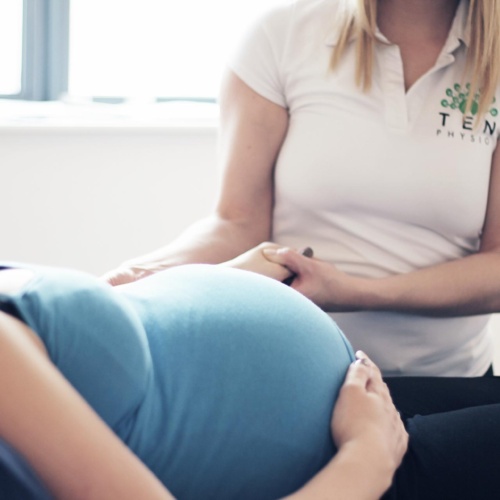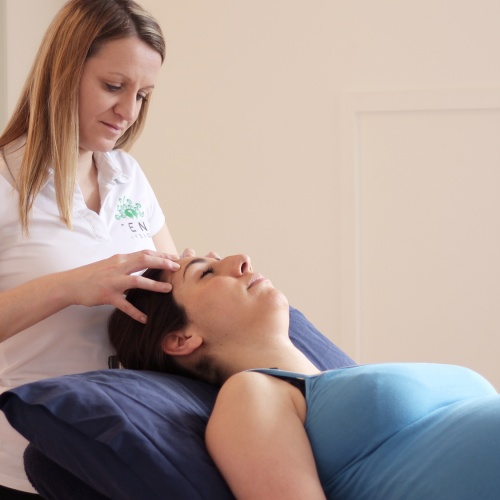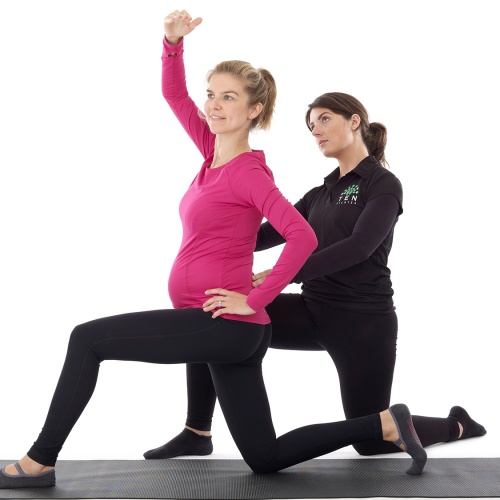When you discover that you’re pregnant, you’ll hope for the healthiest and most stress-free pregnancy possible. However, some women may discover they have a pregnancy-related condition which can make them feel unsure or unsafe doing exercise. This article will outline some common conditions that many women go through during their pregnancies, how specific, targeted exercises in a one-to-one training session can help, and how they can be adapted for home use.
Before continuing, please note that if you are pregnant – regardless of whether or not you have any conditions – you must check with your health advisor/doctor/GP before starting any exercise programme, as some conditions (such as incompetent cervix and some later stages of placenta previa) are completely contraindicated for exercise.
If you have either of those conditions, welcome to a few months of ease and pampering, without a single workout in sight until after the birth! However, there are some slightly more common conditions that you are able to work around (in most cases, and as long as you exercise carefully) two of which are SPD and multiple pregnancies.
Below are some examples of simple but very effective exercises you can do to help you through each of these conditions:
SPD (Symphasis Pubis Disorder)
This is a separation of the softer, more cartilaginous joint between the pelvic bones which can create a ‘clicking’ or ‘rocking’ sensation in the pelvis and can be extremely painful and uncomfortable. Because this disorder involves a separation of the pelvis, exercises that may help prevent the condition worsening are focused around ‘force closing’ of the pelvis:
Three letters – PFE!
Pelvic floor. Pelvic floor. Pelvic floor! No matter what kind of a pregnancy a woman is having – pelvic floor exercises should become as common a daily occurrence as brushing your teeth. If you’re not sure how to find them, imagine you really need the toilet but you’re on the tube 5 stops from home – that sensation of ‘holding it in’ is actually your pelvic floor getting to work! Now, without the full bladder, repeat the same muscular contraction for 3-5 minutes twice a day (let’s say – when you’re brushing your teeth) and it will help you to keep all of your internal muscles strong and ‘pulled together’ and also prepares them to ‘push’ when you’re in labour.
TVA Activation
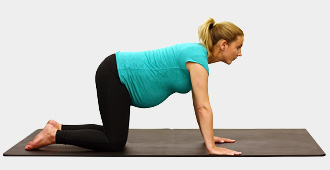
TVA (or ‘inner core’ as it is often referred to) is an important stabilizing muscle for your lower back. Activating this muscle group can also help strengthen your pelvis to try and prevent any further separation of the symphasis pubis.
To activate, carefully get down onto all fours and make sure your knees are directly under your hips and there’s a straight line from wrist to shoulder so your chest is over your hands. Keep your shoulders gently drawn away from your ears and inhale, allowing your TVA/tummy muscles to relax. Breathe out and draw your tummy slowly in towards the lower spine, and at the same time contract/pull in gently with your pelvic floor muscles.
Do it in front of a mirror so that when you contract and hold this movement you should see a nice long flat spine and you should feel your tummy muscles gently pulling in and holding your tummy upwards away from the floor. Making sure you do not ‘round’ the spine, hold this position for a few seconds, then relax on the in-breath. Repeat for 20-30 repetitions or 2-3 minutes.
4 point kneel/’Supermom’

As above, get on all fours with your hips directly over your knees and chest over your hands. Engage your TVA, then carefully extend your left leg directly out behind you on the floor, and then raise your right foot no more than 2-3 inches off the floor, making sure your hips do not lean over to the right. Breathe normally but do not allow your TVA to relax; instead, focus on engaging your TVA to stabilise yourself. After a count of 10 gently bring the toe back to the ground, draw the knee back into the start position and relax the TVA. Repeat on the alternate side, doing 10-15 on each side.
If you feel strong enough, whilst the left leg is extended, try and float the right hand off the ground and then take it back to the ground when you draw the knee back in. This will challenge your inner core and pelvic stabilisers even more. As before, repeat on the opposite side.
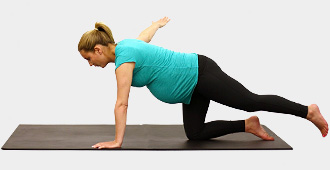
Limit the last, harder progression to 1st and 2nd trimester, and just extend the leg keeping both hands down after this point to remain more stable.
Squat
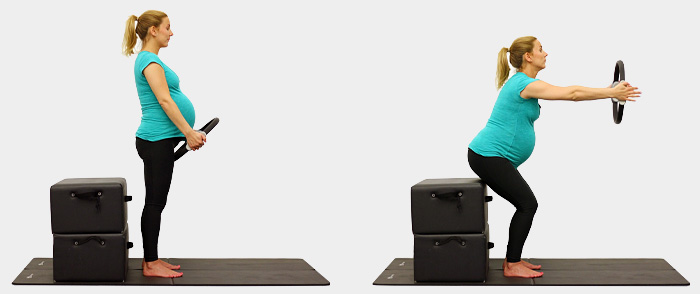
Keeping the glutes strong is also important as they are responsible for a lot of what you do every day in walking/sitting/standing – so a simply adapted squat alongside your PFE and TVA exercises can help to keep your entire pelvis strong.
Stand behind a heavy chair with both hands on it for support. Feet should be no more than hip width apart. Keep your TVA drawn in tight, your pelvic floor engaged and your shoulders relaxed. Slowly lower – as if you were going to sit on a chair behind you – gently keeping your tailbone tucked, your bum gently pushing back behind you and your weight through your heels. Stop about halfway between the floor and your standing height, keeping the weight through your heels and holding for one out-breath and one in-breath. On the next out-breath, squeeze your bum, push through your heels and rise slowly to the original position. Repeat 15-20 times.
Multiple pregnancy
With a multiple pregnancy not much changes in terms of what you are able to do (as your pregnancy develops, your doctor/midwife should advise you of anything specific you need to be aware of ). But obviously, you will be getting much heavier much faster than with a single pregnancy. As a result, you need to support yourself that much more through your glute and core area as you are more likely to suffer from back pain and pelvic weakness.
All of the exercises above for SPD are also brilliant for multiple pregnancies. But what I will add is that – just like any exercise programme – stretches should be incorporated to help ease any areas that are tight, either through exercise/posture or where there is tension, often stress-induced.
Your trainer should recommend some specific stretches for you, but one of the best and most relaxing stretches for lower back/pelvic discomfort is a simple cat/cow.

On all fours, round your back gently up to the ceiling as your breathe out and drop the head in between the arms. As you breathe in gently drop the tummy towards the floor releasing your TVA and bring the head gently up to look at the ceiling. Repeat as desired.
All the simple exercises outlined above can work wonders right the way throughout your pregnancy. When combined with structured strength exercise such as pilates, there is no reason to feel like you’re unable to keep active just because you have a pregnancy related ailment.
As always, never work through any pain or discomfort, and if you ever feel nauseous or dizzy, stop immediately and consult your doctor if you are worried or the symptoms persist.
Overall, the most important thing is to try and enjoy your pregnancy every step of the way, no matter how big or small the steps are!



